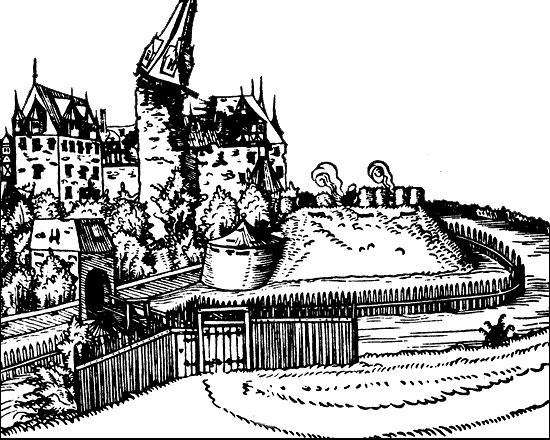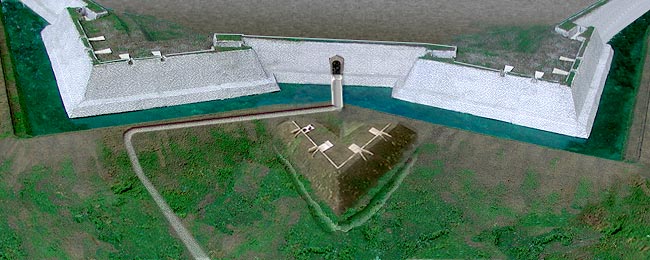 |
Ravelin

On the far side of the bridge, the lightest sort of defending structure was a simple wooden gate and a few meters of wooden fencing to both sides. While this may have held off bandits checking for an opportunity, such was too puny to stop an army.
Something more in keeping with the fort's strength was needed to be in front of the bridge. That something was the ravelin.
The ravelin was beyond the ditch and in line with the gate and bridge. In appearance, a ravelin was like the front part of a bastion: it had two walls as salients that came together at the outer end to make a point. Often, the ravelin was more pointed than the bastions nearby. Before 1650, it was usually open at the end closest to the base fort and was lower than the ramparts it stood before (which enabled defenders in the base fort to fire down into the ravelin should the enemy be overrunning it). Like the base fort, a ravelin could have had a ditch along the outside of the two walls. A synonym occasionally used for ravelin was "demi-lune," especially in French references, and may have been conceived by some earthwork ravelins having a rounded front instead of a point.
The first ravelin was built in 1497, at Sarzanello, and it was masonry. Picturesquely weathered, it remains standing today.
The road from the bridge turned to go behind the ravelin, usually paralleling the ditch until beyond the ravelin. Engineers often extended this parallel farther than the ravelin in order to leave vulnerable to fire an enemy bringing up anything that required a road.

The ravelin is that chevron-shaped structure in the
middle, in front of the bridge and gate. As with the bastions, it
could be a platform for cannon. In this example, the ravelin was built
entirely of earth but could have instead been made with masonry like
the fort behind it.
| Supplementing the Ravelin |
 Dig down
Dig down |
Engineers and military experts realized by the end of the 16th century that a large ravelin provided increased flanking fire to help protect bastions at either side of it. Defenses were then supplemented with ravelins spaced in conjunction with bastions along entire sections of the base fort, sometimes completely around it. Access to these ravelins was from the covered way (to be discussed in a few pages).
Then, before besiegers could make the final assault on the base fort, the 'body of a place,' they had to get past at least one of the ravelins. That meant bombarding it, then taking it, consuming men, material and time.
Flanking fire was also achieved with sconces, which were small, separate and at first as simple as a hole in the ground. In addition, fortifications were put up outside the town or city, some of which were essentially forts.
| Back |
Ensconced in Sconces |
|
|
|